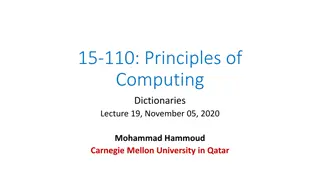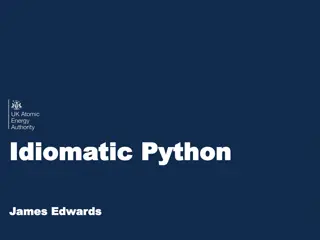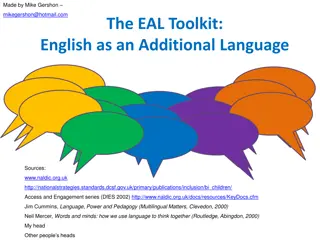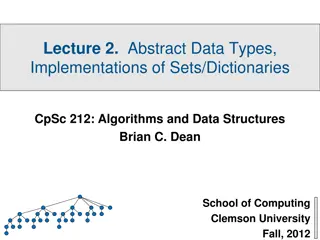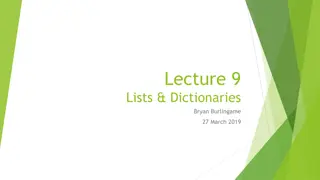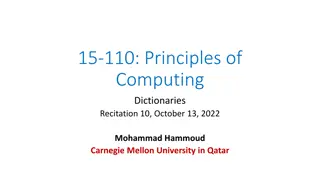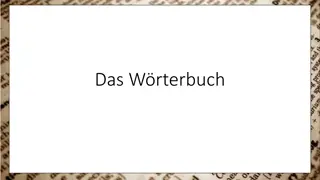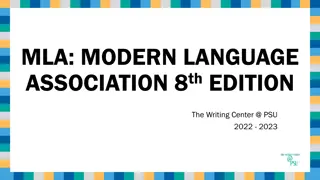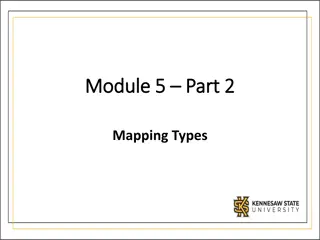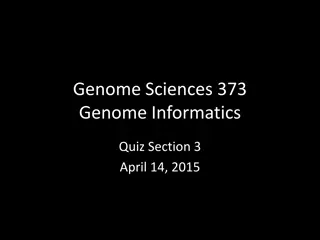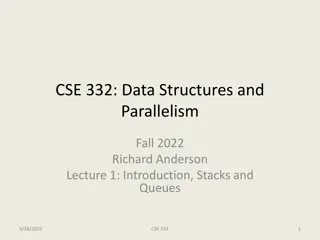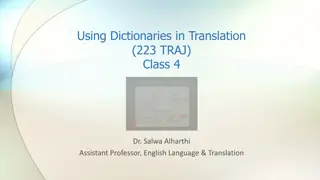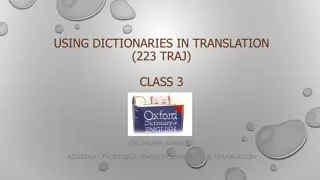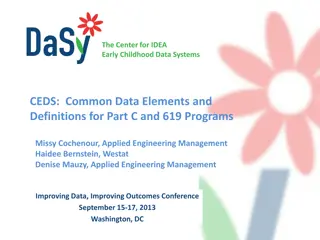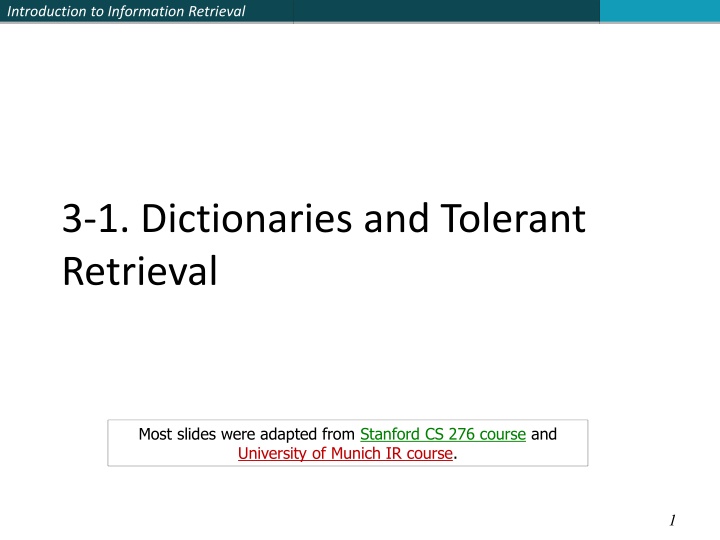
Effective Data Structures for Information Retrieval Systems
This content delves into the importance of dictionary data structures in managing term vocabularies, document frequencies, and pointers to postings lists for efficient information retrieval. It compares hashtable and tree data structures, highlighting their pros and cons in terms of lookup speed, ease of variant finding, prefix search capability, and handling of growing vocabularies. Additionally, it discusses binary trees and B-trees as alternatives, emphasizing their advantages in dealing with character ordering, prefix problems, and tree balancing issues in information retrieval systems.
Download Presentation

Please find below an Image/Link to download the presentation.
The content on the website is provided AS IS for your information and personal use only. It may not be sold, licensed, or shared on other websites without obtaining consent from the author. If you encounter any issues during the download, it is possible that the publisher has removed the file from their server.
You are allowed to download the files provided on this website for personal or commercial use, subject to the condition that they are used lawfully. All files are the property of their respective owners.
The content on the website is provided AS IS for your information and personal use only. It may not be sold, licensed, or shared on other websites without obtaining consent from the author.
E N D
Presentation Transcript
Introduction to Information Retrieval 3-1. Dictionaries and Tolerant Retrieval Most slides were adapted from Stanford CS 276 course and University of Munich IR course. 1
Sec. 3.1 Introduction to Information Retrieval Dictionary data structures for inverted indexes The dictionary data structure stores the term vocabulary, document frequency, pointers to each postings list in what data structure? 2
Sec. 3.1 Introduction to Information Retrieval A na ve dictionary An array of struct: char[20] int Postings * 20 bytes 4/8 bytes 4/8 bytes How do we store a dictionary in memory efficiently? How do we quickly look up elements at query time? 3
Sec. 3.1 Introduction to Information Retrieval Dictionary data structures Two main choices: Hashtables Trees Some IR systems use hashtables, some trees 4
Sec. 3.1 Introduction to Information Retrieval Hashtables Each vocabulary term is hashed to an integer (We assume you ve seen hashtables before) Pros: Lookup is faster than for a tree: O(1) Cons: No easy way to find minor variants: judgment/judgement No prefix search If vocabulary keeps growing, need to occasionally do the expensive operation of rehashing everything [tolerant retrieval] 5
Sec. 3.1 Introduction to Information Retrieval Tree: binary tree Root a-m n-z a-hu hy-m n-sh si-z 6
Sec. 3.1 Introduction to Information Retrieval Tree: B-tree n-z a-hu hy-m Definition: Every internal nodel has a number of children in the interval [a,b] where a, b are appropriate natural numbers, e.g., [2,4]. 7
Sec. 3.1 Introduction to Information Retrieval Trees Simplest: binary tree More usual: B-trees Trees require a standard ordering of characters and hence strings but we typically have one Pros: Solves the prefix problem (terms starting with hyp) Cons: Slower: O(log M) [and this requires balanced tree] Rebalancing binary trees is expensive But B-trees mitigate the rebalancing problem 8
Introduction to Information Retrieval WILD-CARD QUERIES 9
Sec. 3.2 Introduction to Information Retrieval Wild-card queries: * mon*: find all docs containing any word beginning with mon . Easy with binary tree (or B-tree) lexicon: retrieve all words in range: mon w < moo *mon: find words ending in mon : harder Maintain an additional B-tree for terms backwards. Can retrieve all words in range: nom w < non. Exercise: from this, how can we enumerate all terms meeting the wild-card query pro*cent? 10
Sec. 3.2 Introduction to Information Retrieval Query processing At this point, we have an enumeration of all terms in the dictionary that match the wild-card query. We still have to look up the postings for each enumerated term. E.g., consider the query: se*ateANDfil*er This may result in the execution of many Boolean AND queries. 11
Sec. 3.2 Introduction to Information Retrieval B-trees handle * s at the end of a query term How can we handle * s in the middle of query term? co*tion We could look up co* AND *tion in a B-tree and intersect the two term sets Expensive The solution: transform wild-card queries so that the * s occur at the end This gives rise to the Permuterm Index. 12
Sec. 3.2.1 Introduction to Information Retrieval Permuterm index For term hello, index under: hello$, ello$h, llo$he, lo$hel, o$hell, $hello where $ is a special symbol. Queries: X lookup on X$ *X lookup on X$**X* lookup on X* X*Y lookup on Y$X* X* lookup on $X* X*Y*Z ??? Exercise! Query = hel*o X=hel, Y=o Lookup o$hel* 13
Sec. 3.2.1 Introduction to Information Retrieval Permuterm query processing Rotate query wild-card to the right Now use B-tree lookup as before. Permuterm problem: quadruples lexicon size Empirical observation for English. 15
Sec. 3.2.2 Introduction to Information Retrieval Bigram (k-gram) indexes Enumerate all k-grams (sequence of k chars) occurring in any term e.g.,from text April is the cruelest month we get the 2-grams (bigrams) $a,ap,pr,ri,il,l$,$i,is,s$,$t,th,he,e$,$c,cr,ru, ue,el,le,es,st,t$, $m,mo,on,nt,h$ $ is a special word boundary symbol Maintain a second inverted index from bigrams to dictionary terms that match each bigram. 16
Sec. 3.2.2 Introduction to Information Retrieval Bigram index example The k-gram index finds terms based on a query consisting of k-grams (here k=2). $m mace madden mo among amortize on along among 17
Sec. 3.2.2 Introduction to Information Retrieval Processing wild-cards Query mon* can now be run as $m AND mo AND on Gets terms that match AND version of our wildcard query. But we d enumerate moon. Must post-filter these terms against query. Surviving enumerated terms are then looked up in the term-document inverted index. Fast, space efficient (compared to permuterm). 18
Sec. 3.2.2 Introduction to Information Retrieval Processing wild-card queries As before, we must execute a Boolean query for each enumerated, filtered term. Wild-cards can result in expensive query execution (very large disjunctions ) pyth* AND prog* If you encourage laziness people will respond! Search Type your search terms, use * if you need to. E.g., Alex* will match Alexander. Which web search engines allow wildcard queries? 19
Introduction to Information Retrieval Note: Google guide on the * operator 20
Introduction to Information Retrieval SPELLING CORRECTION 22
Sec. 3.3 Introduction to Information Retrieval Spell correction Two principal uses Correcting document(s) being indexed Correcting user queries to retrieve right answers Two main flavors: Isolated word Check each word on its own for misspelling Will not catch typos resulting in correctly spelled words e.g., from form Context-sensitive Look at surrounding words, e.g., I flew form Heathrow to Narita. 23
Sec. 3.3 Introduction to Information Retrieval Document correction Especially needed for OCR ed documents Correction algorithms are tuned for this: rn/m Can use domain-specific knowledge E.g., OCR can confuse O and D more often than it would confuse O and I (adjacent on the QWERTY keyboard, so more likely interchanged in typing). But also: web pages and even printed material have typos Goal: the dictionary contains fewer misspellings But often we don t change the documents and instead fix the query-document mapping 24
Sec. 3.3 Introduction to Information Retrieval Query mis-spellings Our principal focus here E.g., the query Alanis Morisett We can either Retrieve documents indexed by the correct spelling, OR Return several suggested alternative queries with the correct spelling Did you mean ? 25
Sec. 3.3.2 Introduction to Information Retrieval Isolated word correction Fundamental premise there is a lexicon from which the correct spellings come Two basic choices for this A standard lexicon such as Webster s English Dictionary An industry-specific lexicon hand-maintained The lexicon of the indexed corpus E.g., all words on the web All names, acronyms etc. (Including the mis-spellings) 26
Sec. 3.3.2 Introduction to Information Retrieval Isolated word correction Given a lexicon and a character sequence Q, return the words in the lexicon closest to Q What s closest ? We ll study several alternatives Edit distance (Levenshtein distance) Weighted edit distance n-gram overlap 27
Sec. 3.3.3 Introduction to Information Retrieval Edit distance Given two strings S1 and S2, the minimum number of operations to convert one to the other Operations are typically character-level Insert, Delete, Replace, (Transposition) E.g., the edit distance from dof to dog is 1 From cat to act is 2 (Just 1 with transpose.) from cat to dog is 3. Generally found by dynamic programming. See http://www.merriampark.com/ld.htm for a nice example plus an applet. 28
Sec. 3.3.3 Introduction to Information Retrieval Weighted edit distance As above, but the weight of an operation depends on the character(s) involved Meant to capture OCR or keyboard errors Example: m more likely to be mis-typed as n than as q Therefore, replacing m by n is a smaller edit distance than by q This may be formulated as a probability model Requires weight matrix as input Modify dynamic programming to handle weights 29
Sec. 3.3.4 Introduction to Information Retrieval Using edit distances Given query, first enumerate all character sequences within a preset (weighted) edit distance (e.g., 2) Intersect this set with list of correct words Show terms you found to user as suggestions Alternatively, We can look up all possible corrections in our inverted index and return all docs slow We can run with a single most likely correction The alternatives disempower the user, but save a round of interaction with the user 30
Sec. 3.3.4 Introduction to Information Retrieval Edit distance to all dictionary terms? Given a (mis-spelled) query do we compute its edit distance to every dictionary term? Expensive and slow Alternative? How do we cut the set of candidate dictionary terms? One possibility is to use n-gram overlap for this This can also be used by itself for spelling correction. 31
Sec. 3.3.4 Introduction to Information Retrieval n-gram overlap Enumerate all the n-grams in the query string as well as in the lexicon Use the n-gram index (recall wild-card search) to retrieve all lexicon terms matching any of the query n-grams Threshold by number of matching n-grams Variants weight by keyboard layout, etc. 32
Sec. 3.3.4 Introduction to Information Retrieval Example with trigrams Suppose the text is november Trigrams are nov, ove, vem, emb, mbe, ber. The query is december Trigrams are dec, ece, cem, emb, mbe, ber. So 3 trigrams overlap (of 6 in each term) How can we turn this into a normalized measure of overlap? 33
Sec. 3.3.4 Introduction to Information Retrieval One option Jaccard coefficient A commonly-used measure of overlap Let X and Y be two sets; then the J.C. is / X Y X Y Equals 1 when X and Y have the same elements and zero when they are disjoint X and Ydon t have to be of the same size Always assigns a number between 0 and 1 Now threshold to decide if you have a match E.g., if J.C. > 0.8, declare a match 34
Sec. 3.3.4 Introduction to Information Retrieval Matching trigrams Consider the query lord we wish to identify words matching 2 of its 3 bigrams (lo, or, rd) lo alone lore sloth or border lore morbid rd border card ardent Standard postings merge will enumerate Adapt this to using Jaccard (or another) measure. 35
Sec. 3.3.5 Introduction to Information Retrieval Context-sensitive spell correction Text: I flew from Heathrow to Narita. Consider the phrase query flew form Heathrow We d like to respond Did you mean flew from Heathrow ? because no docs matched the query phrase. 36
Sec. 3.3.5 Introduction to Information Retrieval Context-sensitive correction Need surrounding context to catch this. First idea: retrieve dictionary terms close (in weighted edit distance) to each query term Now try all possible resulting phrases with one word fixed at a time flew from heathrow fled form heathrow flea form heathrow Hit-based spelling correction: Suggest the alternative that has lots of hits. 37
Sec. 3.3.5 Introduction to Information Retrieval Exercise Suppose that for flew form Heathrow we have 7 alternatives for flew, 19 for form and 3 for heathrow. How many corrected phrases will we enumerate in this scheme? 38
Sec. 3.3.5 Introduction to Information Retrieval Another approach Break phrase query into a conjunction of biwords (Lecture 2). Look for biwords that need only one term corrected. Enumerate only phrases containing common biwords. 39
Sec. 3.3.5 Introduction to Information Retrieval General issues in spell correction We enumerate multiple alternatives for Did you mean? Need to figure out which to present to the user The alternative hitting most docs Query log analysis More generally, rank alternatives probabilistically argmaxcorrP(corr | query) From Bayes rule, this is equivalent to argmaxcorrP(query | corr) * P(corr) Noisy channel Language model 40
Introduction to Information Retrieval SOUNDEX 41
Sec. 3.4 Introduction to Information Retrieval Soundex Class of heuristics to expand a query into phonetic equivalents Language specific mainly for names E.g., chebyshev tchebycheff Invented for the U.S. census in 1918 42
Sec. 3.4 Introduction to Information Retrieval Soundex typical algorithm Turn every token to be indexed into a 4-character reduced form Do the same with query terms Build and search an index on the reduced forms (when the query calls for a soundex match) http://www.creativyst.com/Doc/Articles/SoundEx1/SoundEx1.htm#Top 43
Sec. 3.4 Introduction to Information Retrieval Soundex typical algorithm 1. Retain the first letter of the word. 2. Change all occurrences of the following letters to '0' (zero): 'A', E', 'I', 'O', 'U', 'H', 'W', 'Y'. 3. Change letters to digits as follows: B, F, P, V 1 C, G, J, K, Q, S, X, Z 2 D,T 3 L 4 M, N 5 R 6 44
Sec. 3.4 Introduction to Information Retrieval Soundex continued 4. Remove all pairs of consecutive digits. 5. Remove all zeros from the resulting string. 6. Pad the resulting string with trailing zeros and return the first four positions, which will be of the form <uppercase letter> <digit> <digit> <digit>. E.g., Herman becomes H655. Will hermann generate the same code? 45
Sec. 3.4 Introduction to Information Retrieval Soundex Soundex is the classic algorithm, provided by most databases (Oracle, Microsoft, ) How useful is soundex? Not very for information retrieval Okay for high recall tasks (e.g., Interpol), though biased to names of certain nationalities Zobel and Dart (1996) show that other algorithms for phonetic matching perform much better in the context of IR 47


